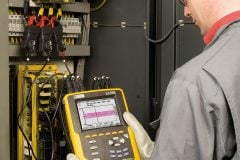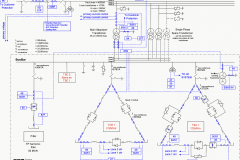Reactive Power Compensation
Except in a very few special situations, electrical energy is generated, transmitted, distributed, and utilized as alternating current (AC). However, alternating current has several distinct disadvantages. One of these is the necessity of reactive power that needs to be supplied along with active power. Reactive power can be leading or lagging.While it is the active power that contributes to the energy consumed, or transmitted, reactive power does not contribute to the energy. Reactive power is an inherent part of the ‘‘total power.’’
Reactive power is either generated or consumed in almost every component of the system, generation, transmission, and distribution and eventually by the loads. The impedance of a branch of a circuit in an AC system consists of two components, resistance and reactance.
Reactance can be either inductive or capacitive, which contribute to reactive power in the circuit.Most of the loads are inductive, and must be supplied with lagging reactive power. It is economical to supply this reactive power closer to the load in the distribution system.
Reactive power compensation in power systems can be either shunt or series.
Shunt Reactive Power Compensation
Since most loads are inductive and consume lagging reactive power, the compensation required is usually supplied by leading reactive power. Shunt compensation of reactive power can be employed either at load level, substation level, or at transmission level.
It can be capacitive (leading) or inductive (lagging) reactive power, although in most cases compensation is capacitive. The most common form of leading reactive power compensation is by connecting shunt capacitors to the line.
Shunt Capacitors
Shunt capacitors are employed at substation level for the following reasons:
Voltage regulation
The main reason that shunt capacitors are installed at substations is to control the voltage within required levels. Load varies over the day, with very low load from midnight toearly morning and peak values occurring in the evening between 4 PM and 7 PM. Shape of the load curve also varies from weekday to weekend, with weekend load typically low.
As the load varies, voltage at the substation bus and at the load bus varies. Since the load power factor is always lagging, a shunt connected capacitor bank at the substation can raise voltage when the load is high. The shunt capacitor banks can be permanently connected to the bus (fixed capacitor bank) or can be switched as needed. Switching can be based on time, if load variation is predictable, or can be based on voltage, power factor, or line current.
Reducing power losses
Compensating the load lagging power factor with the bus connected shunt capacitor bank improves the power factor and reduces current flow through the transmission lines, transformers, generators, etc. This will reduce power losses (I2R losses) in this equipment.
Increased utilization of equipment
Shunt compensation with capacitor banks reduces kVA loading of lines, transformers, and generators, which means with compensation they can be used for delivering more power without overloading the equipment. Reactive power compensation in a power system is of two types—shunt and series. Shunt compensation can be installed near the load, in a distribution substation, along the distribution feeder, or in a transmission substation.
Each application has different purposes.
Shunt reactive compensation can be inductive or capacitive. At load level, at the distribution substation, and along the distribution feeder, compensation is usually capacitive. In a transmission substation, both inductive and capacitve reactive compensation are installed.











Can u tell me the nature of reactive power compensation for peak load and off peak load condition.
Hi
I am little bit confused to compensate pf near unity or 0.97 at 132KV grid station on 11KV side.
As fixed capacitors are connected in circuit, the pf becomes 0.94 capacitive and without connected capacitor pf is 0.93 lagging in normal or peak load condition. Total 36 capacitors are installed out of which 18 are connected for balancing, each of capacitor unit is 150KVAR capacity.
Kindly guide me in this regard so that power factor not go on capacitive side.
Hi
I have confusion regarding no of capacitors to b connected in circuit of 132/11KV Transformer on 11KV side to compensate reactive power and to improve power factor.
For example
if transformer is 20/26MVA with peak load about 640A, pf of 0.94 lagging and reactive power loss of 3000KVARH. Now how what no of capacitors connected to reduce reactive loss and improve power factor.
Hi Edvard,
Many thanks for your explanation about the reactive power. My question is if we can keep voltage on feeders is almost constant by using shunt capacitors, so why utilities are worrying about the high penetration of toproof Solar Panel installation?
Thanks
hi, thanks for this information please can u help me i need information about shunt inductive compensation if you can.
Soon it will be published an article about issue you’re interested in. Stay in tune!